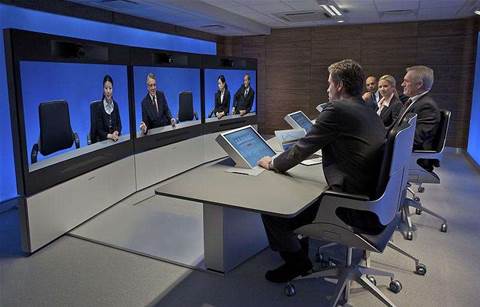Networking-equipment maker Cisco gave the sector a shot in the arm last month when it launched a $US3 billion ($3.25 billion) bid for Norwegian videoconferencing leader Tandberg.
Wainhouse ranks it a "huge deal" with profound impact. "The ripple effect for the . . . market is likely to continue for months," says Wainhouse senior researcher and partner, Ira Weinstein.
"A Cisco-Tandberg merger will drive some companies into the hands of others while causing some alliances to be broken."
Weinstein says it's also a tacit admission on the part of Cisco chief executive officer John Chambers that the networking giant's proprietary technology strategy was "fundamentally flawed".
"While Cisco was able to sell above the videoconferencing manager in many situations, this only partially disguised that the market is looking for standards-based, interoperable solutions that span the conference room to the desktop to the home."
Tandberg's pending sale doesn't faze Nectarios Lazaris, group IT operations manager for architects Woods Bagot, who recently had national reseller iVision install the Norwegians' videoconferencing suites at the global design firm's studios in Sydney, Dubai and San Francisco.
The business integrated it into its unified communications platform that runs Microsoft software. Lazaris says the HD MXP 8000 two-screen systems allow natural communication and collaboration, speed knowledge sharing and give clients confidence the firm's "stars" are working on their projects wherever they are in the world.
He attributes a $440,000 saving from an annual travel budget of $6 million: "You have to put in a
good justification to jump on a plane".
"We've taken it further and the Microsoft Office Communicator and Tandberg videoconferencing solution are one unified comms," he says. The business now uses videoconferencing for all board meetings, bringing together directors irrespective of their geographies.
Lazaris says a big comfort during the deployment was Tandberg's global reach that meant he didn't have to "know or care" who did the job offshore.
Tandberg's Australian channel manager Adam Britten says the spread of high-quality, business-grade broadband and the National Broadband Network underpin a bright future for videoconferencing that suffered from relatively poor ISDN lines in the past.
"One of the things that held back videoconferencing or unified communications and telepresence was availabilty of bandwidth and the costs," Britten says. "Especially in regional areas it's an inhibitor," he adds.
Systems integrators that sell unified communications potentially have the most to gain from videoconferencing's traditionally fatter margins, he says.
"A systems integrator has an incredible amount to gain by driving a video strategy from within its customer base.
The associated revenue an integrator can bring through from video is quite significant.
"Being more than dialtone and having a visual aspect to it has incredible relevance for that channel," says Britten.
Video conferencing: Face to face, far away
By
Nate Cochrane
on Nov 5, 2009 4:21PM
Page 2 of 5 | Single page
Got a news tip for our journalists? Share it with us anonymously here.
Partner Content

How Expert Support Can Help Partners and SMBs Realize the Full Value of AI

Guiding customers on the uneven path to AI adoption
.jpg&h=142&w=230&c=1&s=1)
New Microsoft CSP rules? Here’s how MSPs can stay ahead with Ingram Micro

MSPs with a robust data protection strategy will achieve market success
_(21).jpg&h=142&w=230&c=1&s=1)
Empowering Sustainability: Schneider Electric's Dedication to Powering Customer Success


+drawn+by+George+Louis+Palmella+Busson+du+Maurier.jpg&h=113&w=200&c=1&s=1)
.jpg&h=113&w=200&c=1&s=1)
.jpg&h=113&w=200&c=1&s=1)






.jpg&w=100&c=1&s=0)










